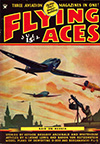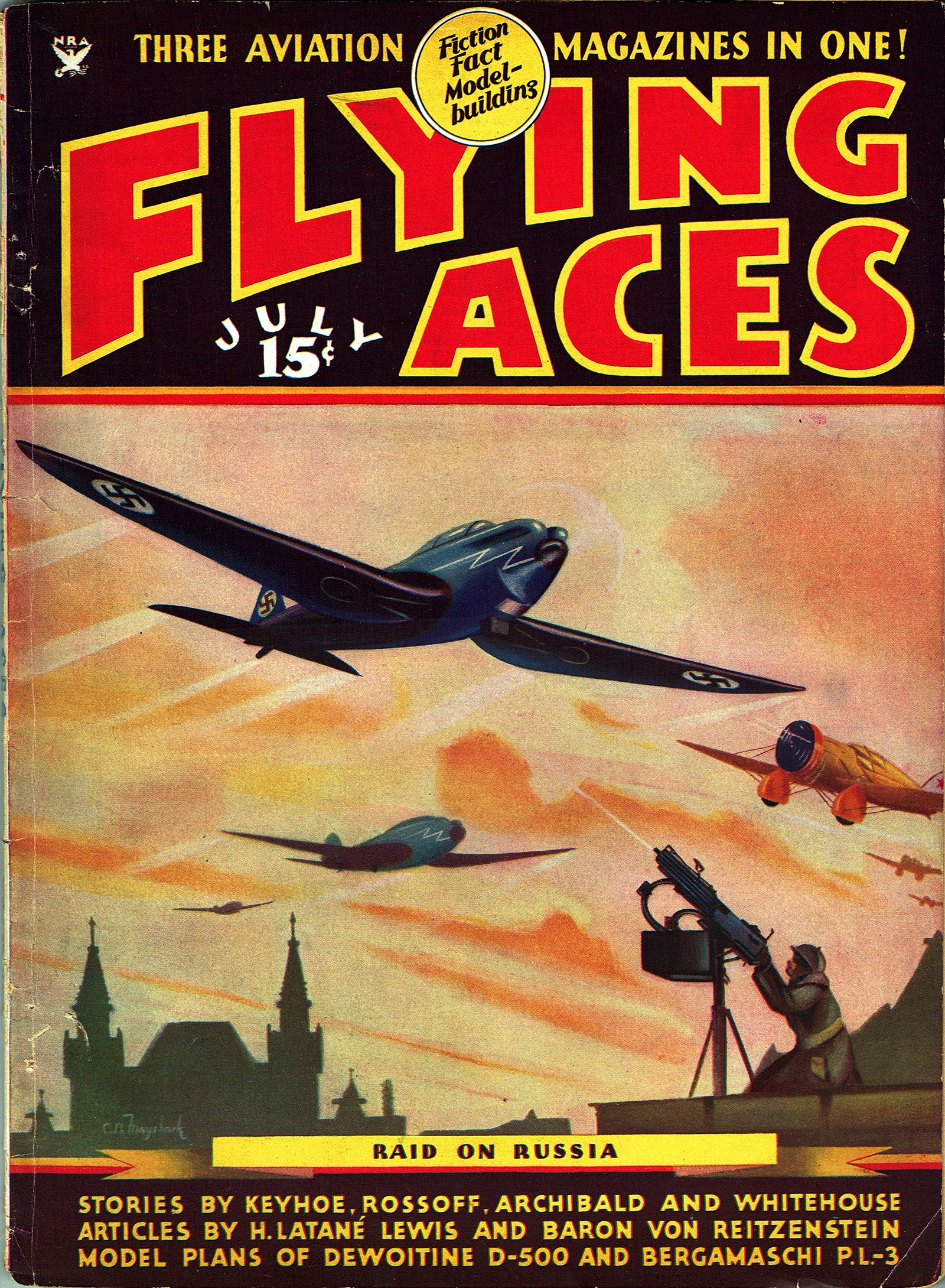“Flying Aces, July 1935″ by C.B. Mayshark
THIS May we are once again celebrating the genius that is C.B. Mayshark! Mayshark took over the covers duties on Flying Aces from Paul Bissell with the December 1934 issue and would continue to provide covers for the next year and a half until the June 1936 issue. While Bissell’s covers were frequently depictions of great moments in combat aviation from the Great War, Mayshark’s covers were often depictions of future aviation battles and planes—like the July 1935 cover where Mayshark gives us a glimpse into a Nazi raid on Russia!
Raid on Russia
 DEATH, destruction, appalling calamity! Crumbling buildings, writhing humanity! The ominous drone of high-powered aircraft, the rattle of machine-gun fire, the detonation of death-dealing explosives! The Nazi insignia over the city of Moscow!
DEATH, destruction, appalling calamity! Crumbling buildings, writhing humanity! The ominous drone of high-powered aircraft, the rattle of machine-gun fire, the detonation of death-dealing explosives! The Nazi insignia over the city of Moscow!
Russian aircraft sound-detectors had flashed the warning many minutes before, and even now, defense ships are taking off. Motor lorries with anti-aircraft guns mounted upon them are being driven to points of vantage throughout the city. Women and children are being herded into bombproof cellars and, except for the scattered military activity, the city looks deserted.
As the German bombers sweep in from the west, Russian pursuit and attack planes close in upon them. The Germans are flying low so as to be sure of their target, for the effectiveness of a bomb depends on where it hits, and the Germans have a certain objective in mind. The Kremlin comes first, then definite military concentration points, and then, if there is time, certain bridges, railroad terminals and important buildings.
But flying low on a bombing expedition is at best a hazardous business. Anti-aircraft has a better chance; then, too, the repercussion is likely to cause damage to the ship from which the bomb is dropped. But the Nazis are taking their chances. The city of Moscow must be destroyed.
There is an old axiom of war which reads: The attacker is always the heaviest loser. After acknowledging this fact and applying it to the present situation, one wonders just how far Germany would get in an air raid on a power that possesses the military strength that is Russia’s. Indeed, it is likely that a flight of bombers would not even get as far as Moscow, for the capital city is a long way from the border. Defense ships in large numbers would have ample time to mobilize and beat off the attackers, and it is a difficult job for a raiding bomber to engage enemy planes and at the same time continue on toward an objective.
But let’s assume that three or four out of the entire flight of raiding bombers manage to reach Moscow. What then? Would the bombs dropped from these ships be sufficient to wipe out the city completely? Probably not. Even if a few bombs were dropped, it is not likely that they would be as effective as they were intended to be. The fierce firing of the anti-aircraft guns, and the dizzy attack of the defense ships would make jockeying for position an extremely difficult task.
Germany’s threat today lies in the air. This much is accepted by every military expert the world over. Her navy, a small but highly efficient arm, has lost much of the prestige it had before the Battle of Jutland and today is really being upheld by the old German Sons of the Sea. The modern German warrior sees not naval history and glory, but winged glory in the skies. The weapons are not dread-naughts, destroyers and the much-hated U-boats, but highspeed fighting bombers, fighters and well-armed single-seaters.
Her threats are not Zeppelin bombs, flame-throwers and Minnies. Fifteen years of careful preparation in defiance of the Treaty of Versailles have brought such terrible weapons as Brisanze bombs, 500-kilo projectiles, each capable of destroying a complete city block. Then there are the new incendiary bombs containing Celsius, a formula that will throw a burning sheet of flame considered to reach 3,000 degrees of temperature. No liquid or damper is known that will quench such a fire. No peace-time fire-fighting equipment could cope with this.
Also, there are their new gas bombs containing the deadly dichlorethyl sulphide, sometimes known as Yellow Cross, which is invisible to the naked eye and which after several hours, only begins to show its symptoms. By that time it is too late. Men die of necrosis of all living tissues including eyes, nose, lungs and throat. They have other gas bombs, too, including Yperite, Blue Cross or Death Dew, which kills men outright in one minute.
If Germany is to attack Russia—a much larger nation, from the point of view of military might—she would have to use amazing surprise methods, and her war would have to be completed in a comparatively short time. With such weapons as explained above, her leaders would hope to overwhelm any European nation within a few days, by simply preying on the moral fibre of the civilian population.
But one might ask, accepting the fact that Germany has all these weapons, what means does she have to convey them to the point of attack? How can Germany build up an efficient air force in such a short time, and train men to handle it?
German efficiency has been accepted for years. Everyone knows that her great commercial air ventures have been produced with only the future air might in view. Her transport planes are like no others anywhere. Her system of sport-flying clubs and schools were nothing but military training organizations. The ships used in these schools were out-and-out military ships—minus such military equipment as bomb-racks, machine guns and camera fittings.
There’s the set-up that Russia, France and England would have to face. Russia is particularly vulnerable to Germany’s air might because of certain geographical conditions.
In the cover illustration, we show one of Germany’s seven-passenger air transports turned into a high-speed fighting bomber. This could be done in eleven hours. The ship is the new Heinkel, capable of 234 miles per hour. We do not know what the flying range is, but there is no doubt that after the conversion job, the ship would be capable of reaching Moscow.
All bombs would be carried within the fuselage, and dropped through a trap door in the floor. Fixed machine guns would be installed somewhere along the top of the engine, firing forward through the propeller. A movable gun would be carried about midway along the top of the fuselage. The ship is powered with a B.M.W. VI twelve-cylinder vee-geared engine. The motor develops 630 horsepower.
The Russian ship is an Ossaviachim Air 7. Figures on performance are unavailable. All we can say about it is that it is a low-wing wire and strut-braced monoplane, and that it is based on the Travel Air “Mystery†monoplane.

Flying Aces, July 1935 by C.B. Mayshark
Raid on Russia: Thrilling Story Behind This Month’s Cover




